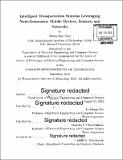Intelligent transportation systems leveraging next-generation mobile devices, sensors, and networks
Author(s)
Gao, Jason Hao
DownloadFull printable version (13.83Mb)
Other Contributors
Massachusetts Institute of Technology. Department of Electrical Engineering and Computer Science.
Advisor
Li-Shiuan Peh and Anantha P. Chandrakasan.
Terms of use
Metadata
Show full item recordAbstract
Urban transportation is becoming increasingly intelligent and connected, with the potential for high societal, economic, and environmental impact as it changes the way we work and live in cities. Mobile apps today already provide navigation, transit prediction, mobility-on-demand, and other transportation services. Other urban transportation challenges, such as managing traffic congestion with high granularity and wide coverage, accessing real-time transportation and city information on-the-go, and deploying driver-less vehicles at scale, are still difficult to address pervasively because existing approaches require costly and slow-to-deploy infrastructure. Our goal is to leverage the technological and marketplace forces of the mobile revolution to build and rapidly deploy pervasive, widespread, infrastructure-less intelligent transportation systems (ITS) that can address the needs of future smart cities. This thesis presents fully-integrated hardware and software systems with working, phone-based prototype deployments in cities. By focusing on pushing new technologies into the device rather than infrastructure, we can realize future ITS for smart cities more rapidly. Together, these systems enable a foundation for resilient, next-generation ITS apps that blur the line between city and software. In the first part of this thesis, we observe the trend of increasingly diverse and varied wireless communications interfaces available on mobile phones, and design and build a prototype of an 802.11p radio that is suited for the power and size constraints mobile devices, allowing them to communicate directly with each other without routing through a router or cellular network. Our evaluation shows reductions in power consumption of 47-56% compared to an off-the-shelf 802.11p radio, and a significantly reduced system footprint, showing that 802.11p can be integrated as a future wireless communications interface on mobile devices. We then propose and design a future ITS application that leverages device-to-device (D2D) communications to enable highly granular, widespread traffic management in cities: RoadRunner. We evaluate RoadRunner with both simulation studies and an experimental deployment on real vehicles to show that it achieves fine-grained traffic management and reduces traffic congestion, while eliminating the need for the costly and coarse-grained infrastructure of existing traffic management systems. In the second part of this thesis, we observe that mobile computing performance is improving rapidly, and propose that future ITS can eschew the traditional client-server approach and instead leverage the heavy-duty computation and D2D communications on the devices to improve user experience. We propose and design a suitable programming model and framework that seamlessly ties together device-centric computation and communications, allowing mobile app develops to easily develop applications in this proposed paradigm. We build and evaluate this programming framework, DIPLOMA, and an example ITS application on top of it, and demonstrate order-of-magnitude improvements in responsiveness/latency and reduced dependence on infrastructure-centric cellular networking. In the final part of this thesis, we observe that mobile sensing is evolving rapidly and incorporating different sensing modalities. We propose that future ITS can use new sensors, such as laser distance sensors, by leveraging heavy-duty mobile computing performance, and design a low-cost laser distance sensor on a mobile phone. We build and evaluate our laser distance sensor in real-world conditions and on autonomous vehicles, and show that our prototype achieves performance suitable for collision avoidance for driver-less vehicles operating at up to 15-18 km/h, costs a fraction of the cost of other comparable laser distance sensors, and straightforwardly leverages improvements in mobile computing performance.
Description
Thesis: Ph. D., Massachusetts Institute of Technology, Department of Electrical Engineering and Computer Science, 2016. Cataloged from PDF version of thesis. Includes bibliographical references (pages 122-137).
Date issued
2016Department
Massachusetts Institute of Technology. Department of Electrical Engineering and Computer SciencePublisher
Massachusetts Institute of Technology
Keywords
Electrical Engineering and Computer Science.